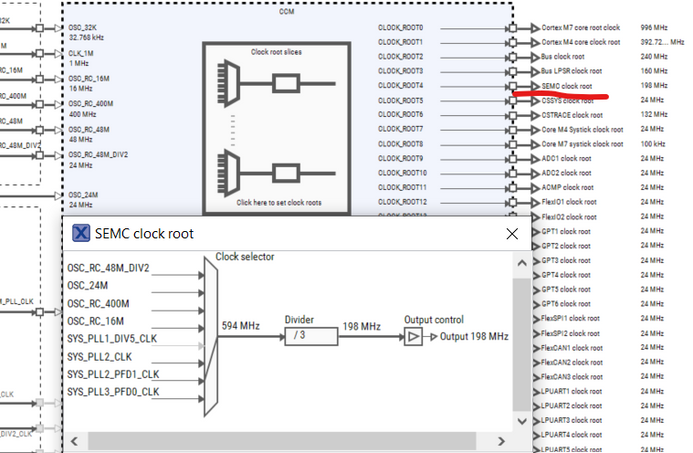- NXP Forums
- Product Forums
- General Purpose MicrocontrollersGeneral Purpose Microcontrollers
- i.MX Forumsi.MX Forums
- QorIQ Processing PlatformsQorIQ Processing Platforms
- Identification and SecurityIdentification and Security
- Power ManagementPower Management
- MCX Microcontrollers
- S32G
- S32K
- S32V
- MPC5xxx
- Other NXP Products
- Wireless Connectivity
- S12 / MagniV Microcontrollers
- Powertrain and Electrification Analog Drivers
- Sensors
- Vybrid Processors
- Digital Signal Controllers
- 8-bit Microcontrollers
- ColdFire/68K Microcontrollers and Processors
- PowerQUICC Processors
- OSBDM and TBDML
-
- Solution Forums
- Software Forums
- MCUXpresso Software and ToolsMCUXpresso Software and Tools
- CodeWarriorCodeWarrior
- MQX Software SolutionsMQX Software Solutions
- Model-Based Design Toolbox (MBDT)Model-Based Design Toolbox (MBDT)
- FreeMASTER
- eIQ Machine Learning Software
- Embedded Software and Tools Clinic
- S32 SDK
- S32 Design Studio
- Vigiles
- GUI Guider
- Zephyr Project
- Voice Technology
- Application Software Packs
- Secure Provisioning SDK (SPSDK)
- Processor Expert Software
-
- Topics
- Mobile Robotics - Drones and RoversMobile Robotics - Drones and Rovers
- NXP Training ContentNXP Training Content
- University ProgramsUniversity Programs
- Rapid IoT
- NXP Designs
- SafeAssure-Community
- OSS Security & Maintenance
- Using Our Community
-
- Cloud Lab Forums
-
- Home
- :
- i.MX Forums
- :
- i.MX RT
- :
- Re: SDRAM frequency test for 133MHZ clock
SDRAM frequency test for 133MHZ clock
- Subscribe to RSS Feed
- Mark Topic as New
- Mark Topic as Read
- Float this Topic for Current User
- Bookmark
- Subscribe
- Mute
- Printer Friendly Page
- Mark as New
- Bookmark
- Subscribe
- Mute
- Subscribe to RSS Feed
- Permalink
- Report Inappropriate Content
Hi team,
Please respond it is urgent.
We are working on imxrt1176 with SDRAM test code
Could you please confirm that event if DCD and clock_config.c and ,h are having changes for new frequency 133mHZ/166MHZ?
and run a sample code of evkmimxrt1170_semc_cm7, effective frequency will be based on settings written in
status_t BOARD_InitSEMC(void)
{
semc_config_t config;
semc_sdram_config_t sdramconfig;
uint32_t clockFrq = EXAMPLE_SEMC_CLK_FREQ;
/* Initializes the MAC configure structure to zero. */
memset(&config, 0, sizeof(semc_config_t));
memset(&sdramconfig, 0, sizeof(semc_sdram_config_t));
/* Initialize SEMC. */
SEMC_GetDefaultConfig(&config);
config.dqsMode = kSEMC_Loopbackdqspad; /* For more accurate timing. */
SEMC_Init(SEMC, &config);
/* Configure SDRAM. */
sdramconfig.csxPinMux = kSEMC_MUXCSX0;
sdramconfig.address = 0x80000000;
sdramconfig.memsize_kbytes = 2 * 32 * 1024; /* 64MB = 2*32*1024*1KBytes*/
sdramconfig.portSize = kSEMC_PortSize32Bit; /*two 16-bit SDRAMs make up 32-bit portsize*/
sdramconfig.burstLen = kSEMC_Sdram_BurstLen8;
sdramconfig.columnAddrBitNum = kSEMC_SdramColunm_9bit;
sdramconfig.casLatency = kSEMC_LatencyThree;
sdramconfig.tPrecharge2Act_Ns = 15; /* tRP 15ns */
sdramconfig.tAct2ReadWrite_Ns = 15; /* tRCD 15ns */
sdramconfig.tRefreshRecovery_Ns = 70; /* Use the maximum of the (Trfc , Txsr). */
sdramconfig.tWriteRecovery_Ns = 2; /* tWR 2ns */
sdramconfig.tCkeOff_Ns =
42; /* The minimum cycle of SDRAM CLK off state. CKE is off in self refresh at a minimum period tRAS.*/
sdramconfig.tAct2Prechage_Ns = 40; /* tRAS 40ns */
sdramconfig.tSelfRefRecovery_Ns = 70;
sdramconfig.tRefresh2Refresh_Ns = 60;
sdramconfig.tAct2Act_Ns = 2; /* tRC/tRDD 2ns */
sdramconfig.tPrescalePeriod_Ns = 160 * (1000000000 / clockFrq);
sdramconfig.refreshPeriod_nsPerRow = 64 * 1000000 / 8192; /* 64ms/8192 */
sdramconfig.refreshUrgThreshold = sdramconfig.refreshPeriod_nsPerRow;
sdramconfig.refreshBurstLen = 1;
sdramconfig.delayChain = 2;
return SEMC_ConfigureSDRAM(SEMC, kSEMC_SDRAM_CS0, &sdramconfig, clockFrq);
}
if so what will be the settings for 133MHZ and 166MHZ SDRAM frequency?
Solved! Go to Solution.
- Mark as New
- Bookmark
- Subscribe
- Mute
- Subscribe to RSS Feed
- Permalink
- Report Inappropriate Content
Hi @anasnadukkandiyil ,
DCD can set clock but BOARD_InitSEMC() can't. DCD is configured in dcd.c. When compile, it will be put in image header. The bootROM can read DCD sector and configure SEMC and clock.
BOARD_InitSEMC() can overwrite SEMC settings but not clock. The SDRAM clock is set in clock_config.c. SDRAM operation speed is same to SEMC clock root.
This picture is copy from MCUXpresso config tool. You can use it to config SDRAM clock easily.
Regards,
Jing
- Mark as New
- Bookmark
- Subscribe
- Mute
- Subscribe to RSS Feed
- Permalink
- Report Inappropriate Content
Hi @anasnadukkandiyil ,
DCD can set clock but BOARD_InitSEMC() can't. DCD is configured in dcd.c. When compile, it will be put in image header. The bootROM can read DCD sector and configure SEMC and clock.
BOARD_InitSEMC() can overwrite SEMC settings but not clock. The SDRAM clock is set in clock_config.c. SDRAM operation speed is same to SEMC clock root.
This picture is copy from MCUXpresso config tool. You can use it to config SDRAM clock easily.
Regards,
Jing
